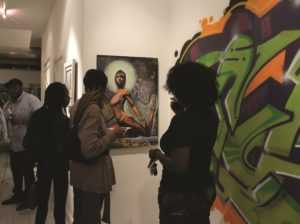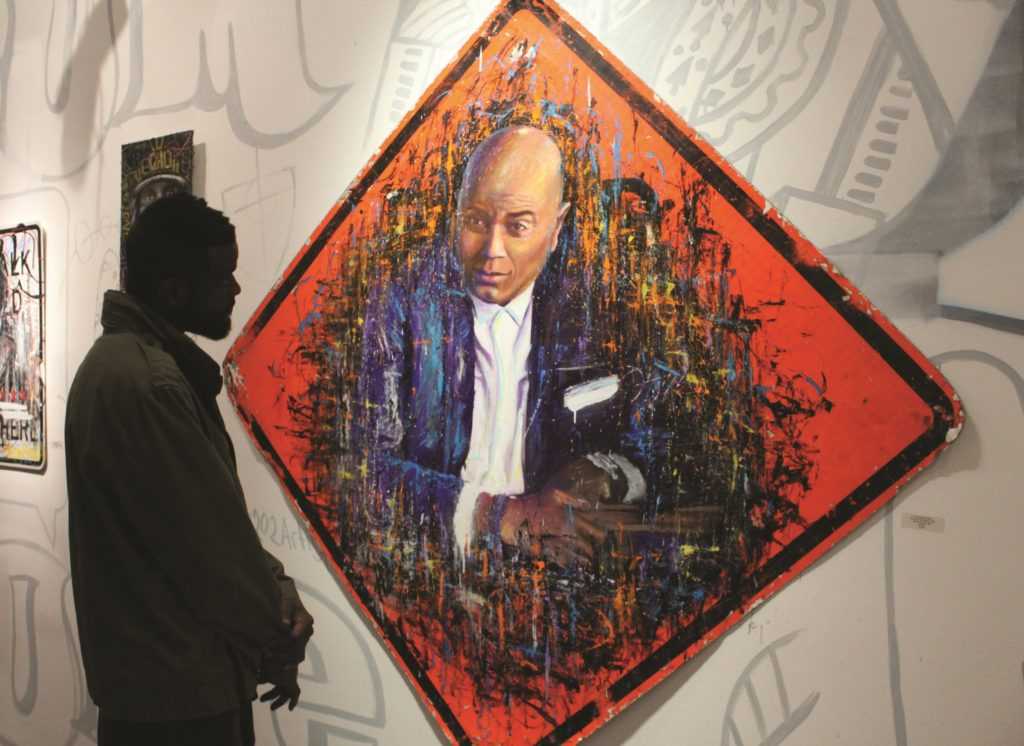Spray-painted walls, graffiti-covered traffic signs and fences adorn the interior of “Love, Hope, and Street Art” at the Honfleur Gallery. The exhibition explores nontraditional forms of artistic expression by placing street art in a museum context.
On Sept. 28, the Honfleur Gallery in the Anacostia neighborhood of Southeast Washington, D.C. opened its doors to celebrate the inauguration of the exhibit “Love, Hope, and Street Art.” The exhibit displays the work of Luis Del Valle, an award-winning D.C.-based artist who is well-known for his social activism and engagement in nontraditional forms such as graffiti, and is complemented by important contributions from DECOY, Corry Stowers, Asad Walker and HKS 181, other local creators who have decades of experience in street art.
Washington, D.C. opened its doors to celebrate the inauguration of the exhibit “Love, Hope, and Street Art.” The exhibit displays the work of Luis Del Valle, an award-winning D.C.-based artist who is well-known for his social activism and engagement in nontraditional forms such as graffiti, and is complemented by important contributions from DECOY, Corry Stowers, Asad Walker and HKS 181, other local creators who have decades of experience in street art.
Street art is often considered a sign of abandonment, but few voices sing of its positive qualities: productive channeling of emotion, inspiration and motivation, and a healthy form of self-expression. “Love, Hope, and Street Art,” challenges that notion by working to tie traditional and street art together.
Upon entering the gallery, a fence with a graffiti-covered traffic sign welcomes visitors. It conveys the messages that the gallery is a private manifestation of feeling upon which one is trespassing, and that the artists’ connections to their streets and their community are so strong they constantly bring them into their art. Nearly halfway through the exhibit, a brick fence stands underneath one of the pieces, giving the impression it has been gradually weathered down, with only a few rows of bricks remaining. The fence again makes audiences think of the connections with their surroundings and now focuses on thoughts of decay and abandonment: streets growing dirtier and cities more contaminated, crowded and dangerous.
The use of street signs, walls, bricks and mundane objects, such as mail stamps as canvases for paintings, gives the impression that art is everywhere, and that almost anything could be used as a platform for social and artistic expression. Through blurred lines, accentuation of color and powerful strokes, the artists evoke the feelings of the subjects depicted and let us imagine their paths. Seeing people represented with such care and detail, and yet in such pandemonium of lines and color, shows the disorder and convolution of human emotion. Del Valle, known for his depictions of regular people as well as famous historical figures, continues with this tradition, showing us strange and familiar faces and detailing more of what they have in common than not — internal and external struggles, a search for place and meaning and a connection to their surroundings and their community.
The most impressive work in the exhibit is presented on a nontraditional canvas: the walls of the gallery. The exhibit is covered with graffiti, at times complementing other pieces, looming large next to or behind them, and at other points serving as a stand-alone statement. The artists dedicated time to spraying across the gallery walls, setting up their work much like they have on the streets of D.C. and the surrounding community for years.
The exhibit shows a wide range of pieces, from less to more complex as one moves along. Starting with tagging, which is simply stylized signatures in a single color, the exhibit moves onto throw-ups, which are more complex than tags but do not use more than two or three colors. Finally, burners — large, more elaborate pieces with a lot of color and contrast, said to be “burning” out of the wall — are on prominent display. These pieces first seem to provide background and context, taking a complementary role to the other art, and then start giving their own message and expression.
Small details in the pieces provide unique moments of pleasure, such as by enjoying a beautifully sprayed butterfly, or admiring an elegant gene strand with the message “we are human” next to it. But the larger messages and images on the walls carry the larger task of complementing the narrative of the exhibit, with messages like “we r 1,” “hope” and “kingdom of people” in grandiose lettering intertwined with artists’ names and signatures.
The exhibit’s emphasis on social activism has its origins in the careers of its creators. “Love, Hope, and Street Art” was borne out of the long-standing relationship between Duane Gautier, the CEO of ARCH, a nonprofit organization working in Anacostia, and Del Valle, a Nicaraguan-born U.S. immigrant who has focused his artistic efforts on community development and inspiration for individuals.
“They have had a great working relationship for many years,” Kadija Bangura, marketing manager at ARCH, said in an interview with The Hoya. “Duane was looking for a way to exhibit Luis’ and other street artists’ work.”
ARCH is a neighborhood-based organization with the mission of revitalizing the historic neighborhood of Anacostia to create opportunities for economic regeneration, artistic expression and community revival. It has oversight of the Honfleur Gallery, the Anacostia Arts Center, the Hive 2.0 and other projects. The Arts Center aims to create a safe space and community center for all forms of artistic expression.
As part of this large network, the Honfleur Gallery shares the purpose of putting on aesthetic and pleasing artistic displays, while providing deep and thoughtful contributions to other organizational efforts, such as social commentary and integration. Del Valle and his collaborators pleasantly succeed at this by putting together an unconventional and dazzling array of commentary and art using various props and forums for both design and message. While “Love, Hope, and Street Art” has some of the expected elements of a traditional art gallery and typical exhibit — painting and sketches neatly fitted into frames and hung straight on the wall — the artists bring in elements from the street and use different canvases to portray the images they use to tell their stories.
“Love, Hope, and Street Art” drives home messages of using art to develop communities, the beauty and value of street art and the struggles of humanity we can see around city areas that at times seem ignored. This work invites people to work on initiatives and projects like ARCH to bring attention to forgotten areas and to do our best to help and honor them.









